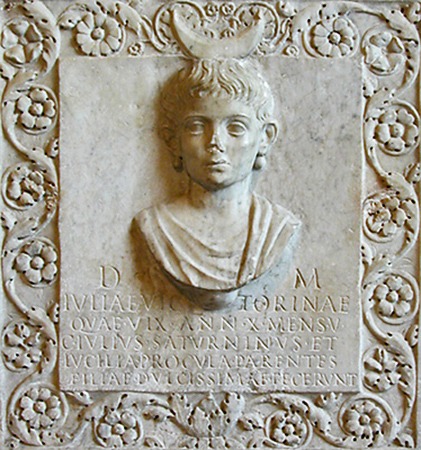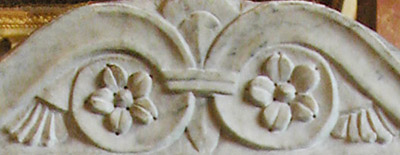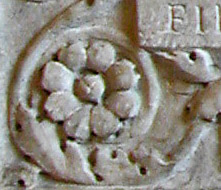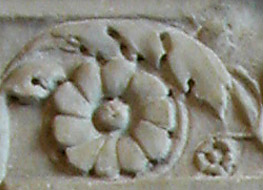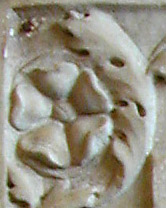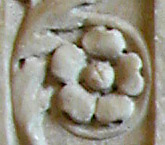Botanicals on the Funerary Altar for Julia Victorina
The plant life depicted on the front and back of this altar is so distinctive for its luxuriance and diversity that the site editors asked Mark Griffiths, a leading British botanist and Fellow of the Linnean Society, to identify the originals that the ancient craftsperson(s) so laboriously portrayed in stone in close detail on the altar's cover and within its bordering frames. His generous response is included in the descriptions below.
Acanthus
Stylized acanthus leaves (
Acanthaceae) spring from a central plant at the bottom of the frame, curling up and around the border that decorates both the front and
back panel of the altar, surrounding and connecting the various florals.
Flowers
We could plump for heavily
stylized roses or
pomegranate flowers or
poppies – that's the usual and somewhat idle catch-all interpretation of such stone blooms. But there are some anomalies on this altar which, I think, invite us to look more deeply. I see flowers of a possible five different species here. Classical botany was far more developed than modern botanists and art historians give it credit for. As with, say, the pastoral of the English Renaissance, some keynote species percolated into the mass consciousness and became icons and emblems. Assuming the stone mason knew what he was doing (and why not?), I think we're entitled to see the following:
Fruit tree blooms
: Julia Victorina's altar cover bears, within volutes created by a fringed ribbon, two flowers at its central apex. The five petals with their distinct midlines are strongly suggestive of the flowers of trees in the Rosaceae. Let's say tentatively that they are the flowers of a crab apple or edible apple (Malus), or a pear (Pyrus), or perhaps even of a cherry (Prunus). The conical structure at the flowers' centres is probably an attempt to represent a cluster of golden stamens.
Daisies
: Two identical multi-petalled flowers with central bosses are placed and on either side of the half-moon device. These look like members of the daisy family (Asteraceae) – perhaps marigolds, ox-eye daisies or corn chrysanthemums, all familiar to Roman gardeners, naturalists and pastoral poets. This multi-petalled flower is repeated in the bottom corners of the border.
Roses
: Beside them in the top corners, two distinctive flowers with no marked central boss and five markedly wedge-shaped petals apiece. These look like roses (of the genus Rosa) – indeed, the Renaissance tradition of depicting eglantine and other single-flowered roses follows this convention exactly, and was derived from Classical artifacts such as this altar.
Anemones
: On each tip of the altar cover and running down the sides of the border are flowers with central bosses and five broad and notched petals. None of these, in my view, is meant to be the same as those described above. I would tentatively identify these as belonging to one of the several related and similar scarlet-flowered species associated with the metamorphosis of Adonis and thus with grief at the loss of a young life (i.e. Anemone coronaria or Adonis annua and Adonis aestivalis). Nowadays, you will see these plants with more than five petals per flower, but that is usually the result of thousands of years of breeding and selection. The basic complement is five petals, and that would have been the natural number for a Roman sculptor to depict.
Violets
: Here things become very interesting. Second from bottom on the right and left sides, you have a zygomorphic flower – that is, a flower with only one plane of symmetry (in this case running vertically through its midline). These are the only zygomorphic flowers I've seen in Classical carvings – but then I haven't seen that many carvings. Likely candidates include irises (perhaps Iris germanica), a greatly enlarged orchid flower (Orchis species), or a violet (Viola odorata or something similar). I favour the violet option, as I believe that what looks like the top petal (the inrolled-looking, almost wheat-grain-like structure) is not a petal but the mason's attempt to show the hind portions of the flower in perspective. In other words, the violet's five rightful petals are expanding from this uppermost structure, as indeed they do in life.
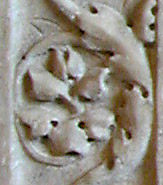

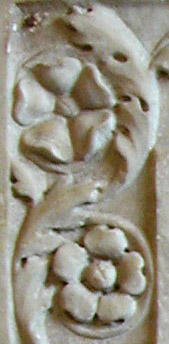

There is a natural order, or harmony, in placing the tree blossoms at the top of the monument and the low-growing shade-dwelling violet toward the bottom. Again, these flowers are strongly suggestive of spring and of rejuvenation, but they also have a memento mori undertone – blossom, like Horace's snow (Carmina IV.7: Diffugere nives), scatters all too quickly. Here we have an exquisite essay in Roman pastoral, a spring meadow in stone. It includes flowers of celebration and rejuvenation and flowers associated with dying too young. All of these floral associations are strongly supported by Classical mythology and poetry, so why not include them in a memorial? Imagine this altar painted or as it must have appeared, wrapped in an actual garland, at the time of its mournful dedication. It would have been an astonishingly colourful sight: a green background (Acanthus), picked out with white (fruit tree blossoms), gold (daisies), pink (roses), scarlet (anemones) and purple (violets). Unlike the solemn funerary wreath of laurel leaves decorating some monuments, this memorial preserves a vibrant botanical arrangement more suggestive of life and a wedding celebration than a funeral.
